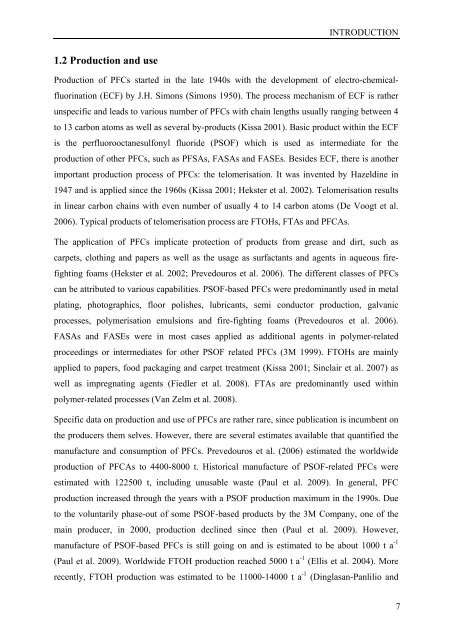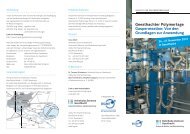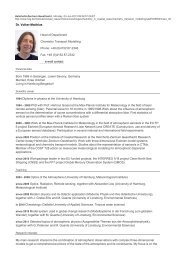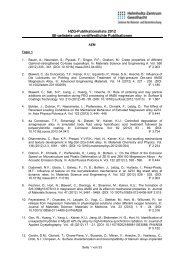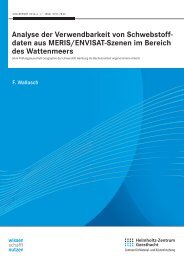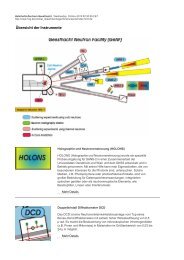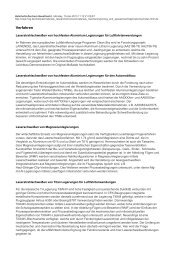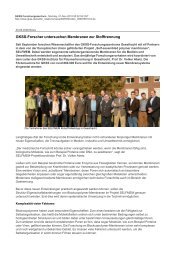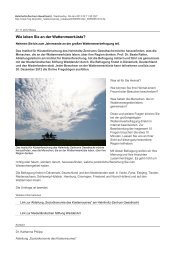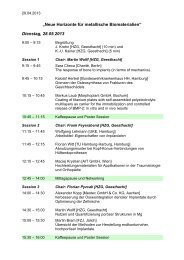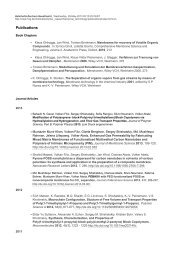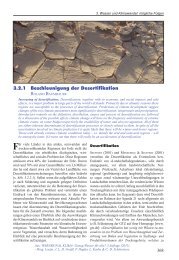Landfills and waste water treatment plants as sources of ... - GKSS
Landfills and waste water treatment plants as sources of ... - GKSS
Landfills and waste water treatment plants as sources of ... - GKSS
Create successful ePaper yourself
Turn your PDF publications into a flip-book with our unique Google optimized e-Paper software.
1.2 Production <strong>and</strong> use<br />
INTRODUCTION<br />
Production <strong>of</strong> PFCs started in the late 1940s with the development <strong>of</strong> electro-chemicalfluorination<br />
(ECF) by J.H. Simons (Simons 1950). The process mechanism <strong>of</strong> ECF is rather<br />
unspecific <strong>and</strong> leads to various number <strong>of</strong> PFCs with chain lengths usually ranging between 4<br />
to 13 carbon atoms <strong>as</strong> well <strong>as</strong> several by-products (Kissa 2001). B<strong>as</strong>ic product within the ECF<br />
is the perfluorooctanesulfonyl fluoride (PSOF) which is used <strong>as</strong> intermediate for the<br />
production <strong>of</strong> other PFCs, such <strong>as</strong> PFSAs, FASAs <strong>and</strong> FASEs. Besides ECF, there is another<br />
important production process <strong>of</strong> PFCs: the telomerisation. It w<strong>as</strong> invented by Hazeldine in<br />
1947 <strong>and</strong> is applied since the 1960s (Kissa 2001; Hekster et al. 2002). Telomerisation results<br />
in linear carbon chains with even number <strong>of</strong> usually 4 to 14 carbon atoms (De Voogt et al.<br />
2006). Typical products <strong>of</strong> telomerisation process are FTOHs, FTAs <strong>and</strong> PFCAs.<br />
The application <strong>of</strong> PFCs implicate protection <strong>of</strong> products from gre<strong>as</strong>e <strong>and</strong> dirt, such <strong>as</strong><br />
carpets, clothing <strong>and</strong> papers <strong>as</strong> well <strong>as</strong> the usage <strong>as</strong> surfactants <strong>and</strong> agents in aqueous firefighting<br />
foams (Hekster et al. 2002; Prevedouros et al. 2006). The different cl<strong>as</strong>ses <strong>of</strong> PFCs<br />
can be attributed to various capabilities. PSOF-b<strong>as</strong>ed PFCs were predominantly used in metal<br />
plating, photographics, floor polishes, lubricants, semi conductor production, galvanic<br />
processes, polymerisation emulsions <strong>and</strong> fire-fighting foams (Prevedouros et al. 2006).<br />
FASAs <strong>and</strong> FASEs were in most c<strong>as</strong>es applied <strong>as</strong> additional agents in polymer-related<br />
proceedings or intermediates for other PSOF related PFCs (3M 1999). FTOHs are mainly<br />
applied to papers, food packaging <strong>and</strong> carpet <strong>treatment</strong> (Kissa 2001; Sinclair et al. 2007) <strong>as</strong><br />
well <strong>as</strong> impregnating agents (Fiedler et al. 2008). FTAs are predominantly used within<br />
polymer-related processes (Van Zelm et al. 2008).<br />
Specific data on production <strong>and</strong> use <strong>of</strong> PFCs are rather rare, since publication is incumbent on<br />
the producers them selves. However, there are several estimates available that quantified the<br />
manufacture <strong>and</strong> consumption <strong>of</strong> PFCs. Prevedouros et al. (2006) estimated the worldwide<br />
production <strong>of</strong> PFCAs to 4400-8000 t. Historical manufacture <strong>of</strong> PSOF-related PFCs were<br />
estimated with 122500 t, including unusable <strong>w<strong>as</strong>te</strong> (Paul et al. 2009). In general, PFC<br />
production incre<strong>as</strong>ed through the years with a PSOF production maximum in the 1990s. Due<br />
to the voluntarily ph<strong>as</strong>e-out <strong>of</strong> some PSOF-b<strong>as</strong>ed products by the 3M Company, one <strong>of</strong> the<br />
main producer, in 2000, production declined since then (Paul et al. 2009). However,<br />
manufacture <strong>of</strong> PSOF-b<strong>as</strong>ed PFCs is still going on <strong>and</strong> is estimated to be about 1000 t a -1<br />
(Paul et al. 2009). Worldwide FTOH production reached 5000 t a -1 (Ellis et al. 2004). More<br />
recently, FTOH production w<strong>as</strong> estimated to be 11000-14000 t a -1 (Dingl<strong>as</strong>an-Panlilio <strong>and</strong><br />
7


